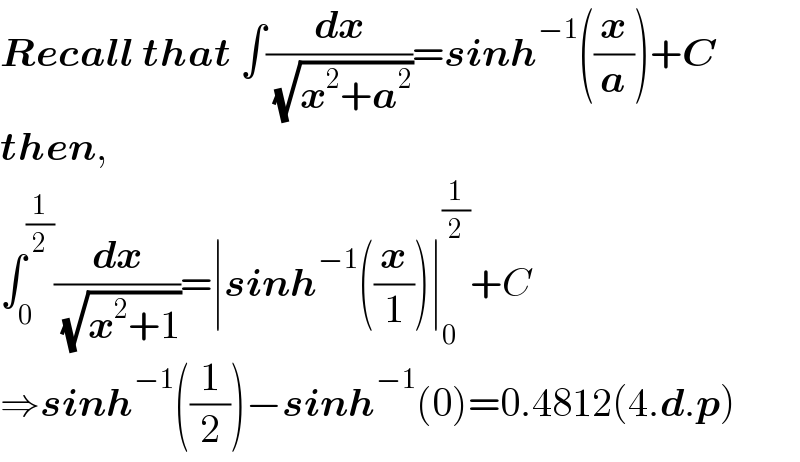
Question Number 200978 by sonukgindia last updated on 27/Nov/23

Answered by BaliramKumar last updated on 27/Nov/23
![put x = tanθ ⇒ dx = sec^2 θdθ ∫ (1/( (√(tan^2 θ+1))))sec^2 θdθ ∫ secθdθ = ln(secθ + tanθ) ⇒ ln((√(tan^2 θ+1)) + tanθ) ⇒ [ ln((√(x^2 +1)) + x)]_0 ^(1/2) = ln(((1+(√5))/2)) = 0.4812](Q200990.png)
$$\mathrm{put}\:\:\:\mathrm{x}\:=\:\mathrm{tan}\theta\:\:\Rightarrow\:\:\:\:\:\:\:\:\:\mathrm{dx}\:=\:\mathrm{sec}^{\mathrm{2}} \theta\mathrm{d}\theta \\ $$$$\int\:\frac{\mathrm{1}}{\:\sqrt{\mathrm{tan}^{\mathrm{2}} \theta+\mathrm{1}}}\mathrm{sec}^{\mathrm{2}} \theta\mathrm{d}\theta \\ $$$$\int\:\mathrm{sec}\theta\mathrm{d}\theta\:=\:\mathrm{ln}\left(\mathrm{sec}\theta\:+\:\mathrm{tan}\theta\right) \\ $$$$\Rightarrow\:\:\mathrm{ln}\left(\sqrt{\mathrm{tan}^{\mathrm{2}} \theta+\mathrm{1}}\:+\:\mathrm{tan}\theta\right) \\ $$$$\Rightarrow\:\left[\:\mathrm{ln}\left(\sqrt{\mathrm{x}^{\mathrm{2}} +\mathrm{1}}\:+\:\mathrm{x}\right)\right]_{\mathrm{0}} ^{\frac{\mathrm{1}}{\mathrm{2}}} \:=\:\mathrm{ln}\left(\frac{\mathrm{1}+\sqrt{\mathrm{5}}}{\mathrm{2}}\right)\:=\:\mathrm{0}.\mathrm{4812} \\ $$$$ \\ $$$$ \\ $$
Answered by MM42 last updated on 27/Nov/23
![I=ln(x+(√(1+x^2 )))]_0 ^(1/2) =ln(((1+(√5))/2) ) ✓](Q200993.png)
$$\left.{I}={ln}\left({x}+\sqrt{\mathrm{1}+{x}^{\mathrm{2}} }\right)\right]_{\mathrm{0}} ^{\frac{\mathrm{1}}{\mathrm{2}}} ={ln}\left(\frac{\mathrm{1}+\sqrt{\mathrm{5}}}{\mathrm{2}}\:\right)\:\:\checkmark \\ $$$$ \\ $$
Answered by Calculusboy last updated on 28/Nov/23

$$\boldsymbol{{Recall}}\:\boldsymbol{{that}}\:\int\frac{\boldsymbol{{dx}}}{\:\sqrt{\boldsymbol{{x}}^{\mathrm{2}} +\boldsymbol{{a}}^{\mathrm{2}} }}=\boldsymbol{{sinh}}^{−\mathrm{1}} \left(\frac{\boldsymbol{{x}}}{\boldsymbol{{a}}}\right)+\boldsymbol{{C}} \\ $$$$\boldsymbol{{then}},\: \\ $$$$\int_{\mathrm{0}} ^{\frac{\mathrm{1}}{\mathrm{2}}} \frac{\boldsymbol{{dx}}}{\:\sqrt{\boldsymbol{{x}}^{\mathrm{2}} +\mathrm{1}}}=\mid\boldsymbol{{sinh}}^{−\mathrm{1}} \left(\frac{\boldsymbol{{x}}}{\mathrm{1}}\right)\mid_{\mathrm{0}} ^{\frac{\mathrm{1}}{\mathrm{2}}} +{C} \\ $$$$\Rightarrow\boldsymbol{{sinh}}^{−\mathrm{1}} \left(\frac{\mathrm{1}}{\mathrm{2}}\right)−\boldsymbol{{sinh}}^{−\mathrm{1}} \left(\mathrm{0}\right)=\mathrm{0}.\mathrm{4812}\left(\mathrm{4}.\boldsymbol{{d}}.\boldsymbol{{p}}\right) \\ $$
